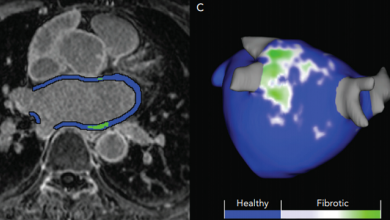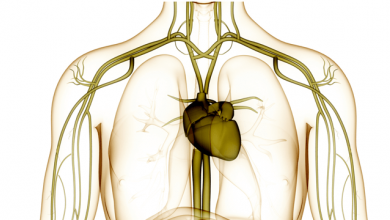Search results
Author(s):
Dario DiFrancesco
Added:
3 years ago
HCN4 (hyperpolarisation-activated, cyclic nucleotide gated 4) channels, the pore-forming α–subunits of ‘funny’ channels originally described in pacemaker cells of the sinoatrial node (SAN),1 are responsible for the early phase of diastolic depolarisation in these cells and are key determinants of pacemaker generation and control of heart rate.2–5 HCN4 channels are selectively expressed in the SAN…
View more
Author(s):
Katarzyna Dudzińska-Szczerba
,
Piotr Kułakowski
,
Ilona Michałowska
,
et al
Added:
1 year ago
CMR and AF Management
Author(s):
Yan Zhao
,
Lilas Dagher
,
Chao Huang
,
et al
Added:
3 years ago
Article
Author(s):
Zhao Liu
,
J Kevin Donahue
Added:
3 years ago
In the United States, atrial fibrillation (AF) is the most common sustained cardiac arrhythmia affecting approximately six million patients and contributing to a greatly increased risk of stroke, heart failure (HF) and overall morbidity and mortality.1,2 The prevalence of AF is increasing as the average age of the population increases.3,4
Currently available therapies for AF are suboptimal…
View more
Author(s):
Ahmed M Al-Kaisey
,
William Figgett
,
Joshua Hawson
,
et al
Added:
1 year ago
Author(s):
Farhan Shahid
,
Gregory YH Lip
Added:
3 years ago
Atrial fibrillation (AF) and heart failure (HF) are global epidemics that began more than a century ago, and their association with an ageing general population has brought about an increase in cardiovascular morbidity and rising healthcare costs.1,2 More than 50 % of patients with permanent AF have a concurrent diagnosis of HF and this proportion is expected to rise.3 It is well established that…
View more
Author(s):
Giulio Conte
,
Ulrich Schotten
,
Angelo Auricchio
Added:
3 years ago
The Risk of Atrial Arrhythmias in Inherited Primary Arrhythmia Syndromes
The inherited primary arrhythmia syndromes (IPAS) are a heterogeneous group of diseases caused by mutations in genes encoding for cardiac ion channels. People affected by one of these inherited diseases have no overt structural cardiac abnormalities but are at higher risk of sudden cardiac death due to the occurrence of…
View more
Author(s):
Jean-Baptiste Gourraud
,
Jason G Andrade
,
Laurent Macle
,
et al
Added:
3 years ago
Atrial fibrillation (AF) is the most common sustained cardiac arrhythmia observed in clinical practice, occurring in approximately 2 % of the general population.1–3 A progressive increase in both the prevalence and incidence of AF has been demonstrated in recent years, defining AF as a major economic and public health issue.1
The identification of sites of AF initiation and/or maintenance within…
View more
Author(s):
Jing Xian Quah
,
Dhani Dharmaprani
,
Anandaroop Lahiri
,
et al
Added:
2 years ago
Author(s):
Andreas Goette
,
Hein Heidbuchel
Added:
3 years ago
AF is the most common sustained cardiac arrhythmia and poses a significant public health challenge.1 In cases of AF, if sinus rhythm does not spontaneously return, cardioversion may be needed to alleviate symptoms and to improve cardiac performance.2 This may be performed by pharmacological methods, i.e. the administration of antiarrhythmic drugs, which is the preferred strategy in recent-onset…
View more














 « First
« First